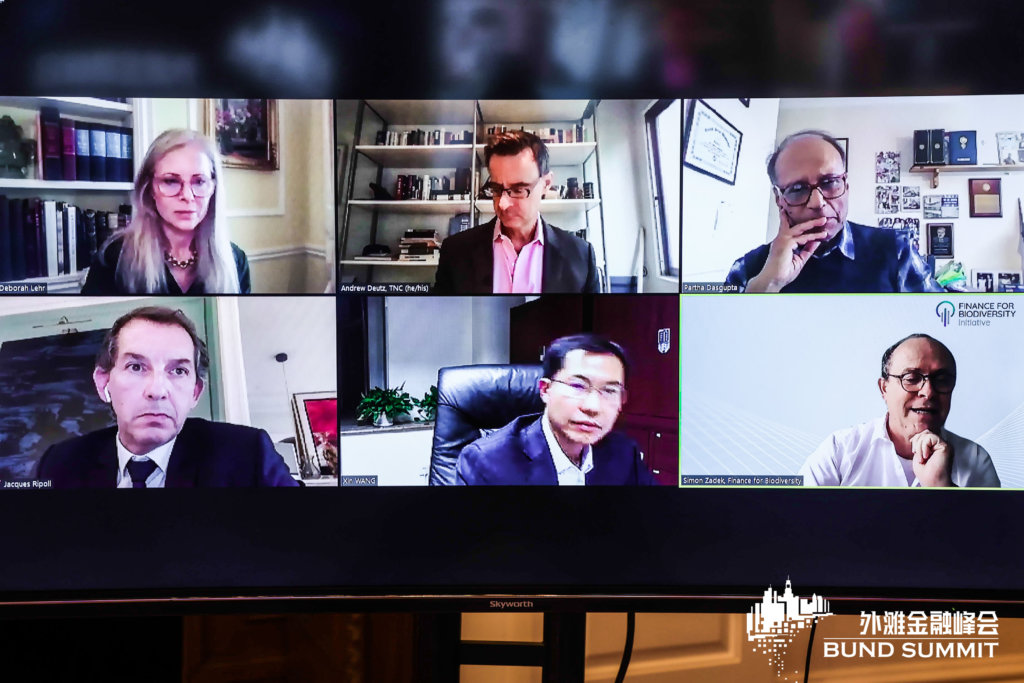The world is losing species at 1,000 times the natural rate. Figures like this are daunting and speak to the paramount importance of the biodiversity challenge. In this context, the Paulson Institute and the China Finance 40 Forum (CF40) co-hosted a panel session titled Financing Biodiversity: Actions and Challenges on the sidelines of the CF40’s third Bund Summit on October 23, 2021.

Deborah Lehr, Vice Chairman and Executive Director of the Paulson Institute moderated the panel, which featured distinguished global experts working on the frontlines of the space in academia, policy and business. She was joined in the discussion by Wang Xin, Director-General of Research Bureau for the People’s Bank of China (PBOC); Sir Partha Dasgupta, Frank Ramsey Professor Emeritus of Economics at the University of Cambridge; Simon Zadek, Chair of Finance for Biodiversity; Jacques Ripoll, Chief Executive Officer of Credit Agricole; and Andrew Deutz, Director of Global Policy, Institution and Conversation Finance at The Nature Conservancy.

As nature’s ability to provide the goods and services we have come to depend on dwindles, it presents great economic risks to our current economic system. Guided by the question of how to properly value nature and provide the right conditions and incentives to drive change, the panel discussed the main perspectives and challenges of the biodiversity crisis, practical mechanisms for encouraging the financing needed to fill the gap, and ideas to establish policies that embed nature into economies.
As nature’s ability to provide the goods and services we have come to depend on dwindles, it presents great economic risks to our current economic system.
To start the panel and present the Chinese perspective on financing biodiversity, Wang stated that China’s established green finance system does not sufficiently account for biodiversity at the moment. It has a large focus on carbon due to China’s 30/60 goals especially as related to accounting and disclosure requirements. However, the PBOC is actively considering how to incorporate the value and risks of nature into the financial system, and thinking creatively regarding financial innovations to drive more coordinated finance for both climate and biodiversity, instead of creating incentives for a trade-off.
Our economies are embedded within nature, not external to it.
In setting the scene globally, Sir Dasgupta defined the problem by saying that “nature’s worth to society is not reflected in market prices,” and that it is important to “understand a simple truth that our economies are embedded within nature, not external to it.” Zadek echoed many of the same sentiments and added thoughts on the ongoing effort around attempts to translate the externalities from biodiversity into the language of markets including the pricing of assets and valuing of risks—particularly through the Taskforce on Nature-related Financial Disclosures (TNFD).
Presenting a perspective from the private sector, Ripoll spoke about how business views the biodiversity challenge as important, but often far less a part of the agenda compared to climate. For the finance sector, there is a need for more awareness and robust data to elevate the biodiversity challenge. But it definitely has a role to play since it can influence sectors that are heavily contributing to excessive land and water usage, a large driver of biodiversity loss, such as intensive agriculture, fashion, and infrastructure development as part of urbanization.
For the finance sector, there is a need for more awareness and robust data to elevate the biodiversity challenge.
And in closing, Deutz aptly summed up the key elements of the work ahead by suggesting that stakeholders need to finance green by catalyzing financial support for nature, green finance in a way that mainstreams biodiversity considerations in financial decision making, and address the climate and nature finance challenges in tandem.
Indeed, closing the biodiversity funding gap in a meaningful way that would prevent species loss, reduce deforestation, and properly value nature’s services is imperative to our future prosperity. The first part of COP 15 announced the Kunming Biodiversity Fund, which is sizeable, but far from adequate to address the biodiversity crisis. With the second half of COP 15 next year and as biodiversity rises along with the climate agenda, the outlook for financing nature remains hopeful.



